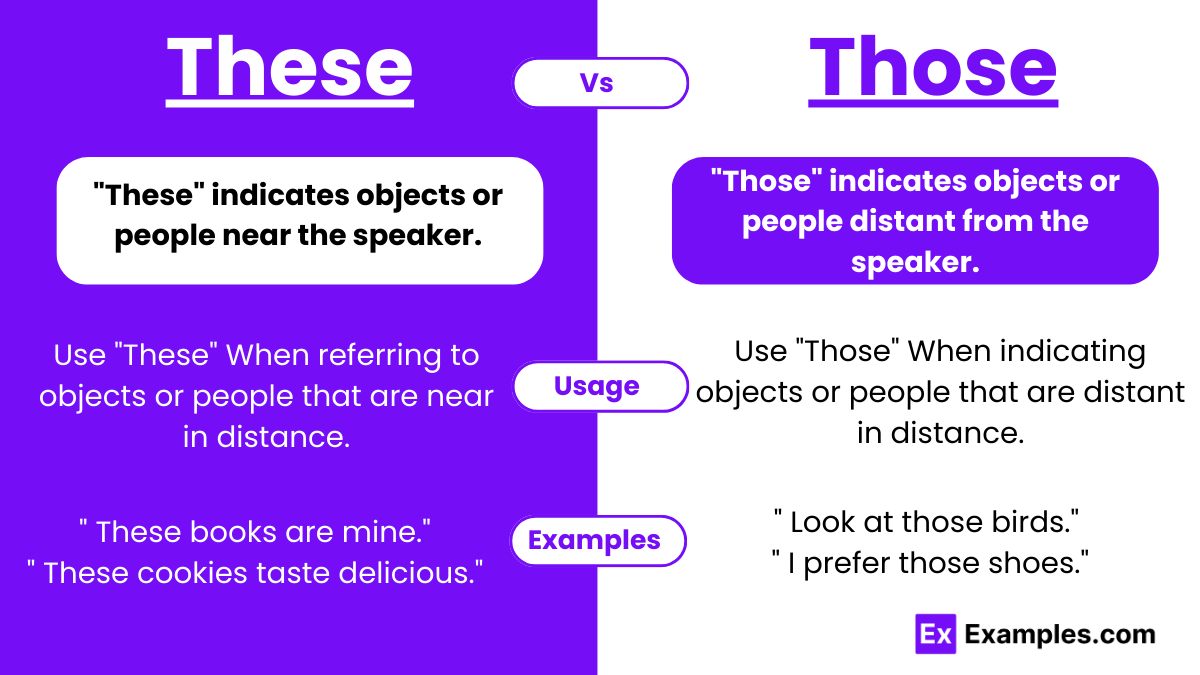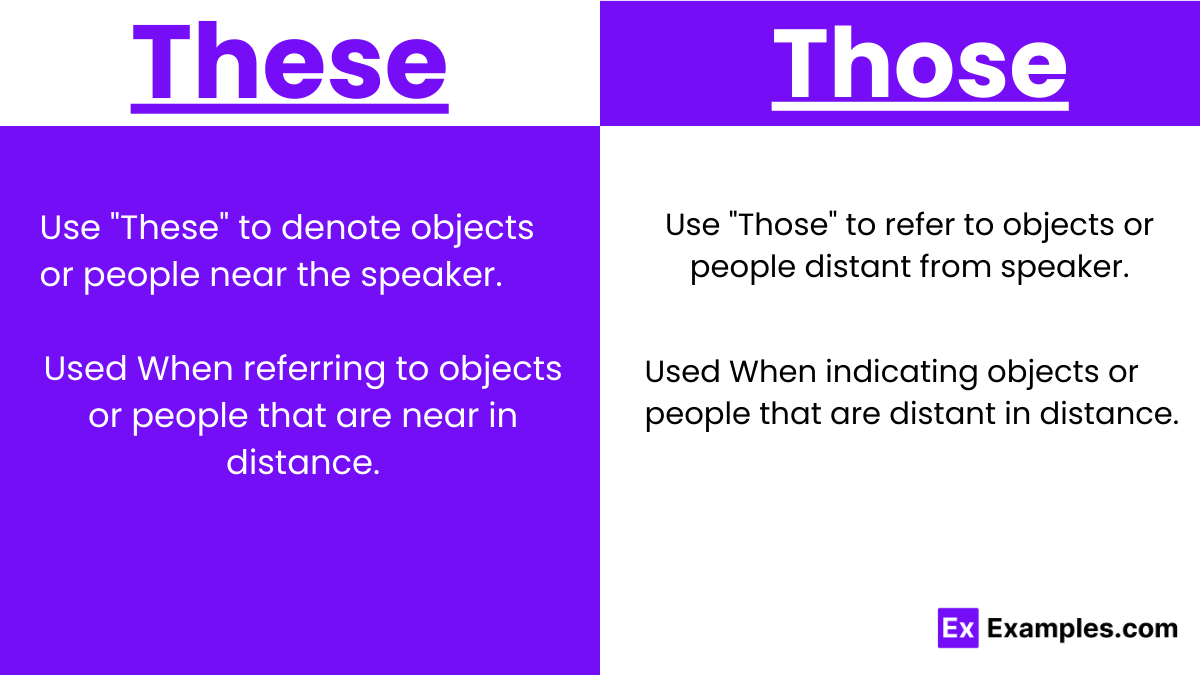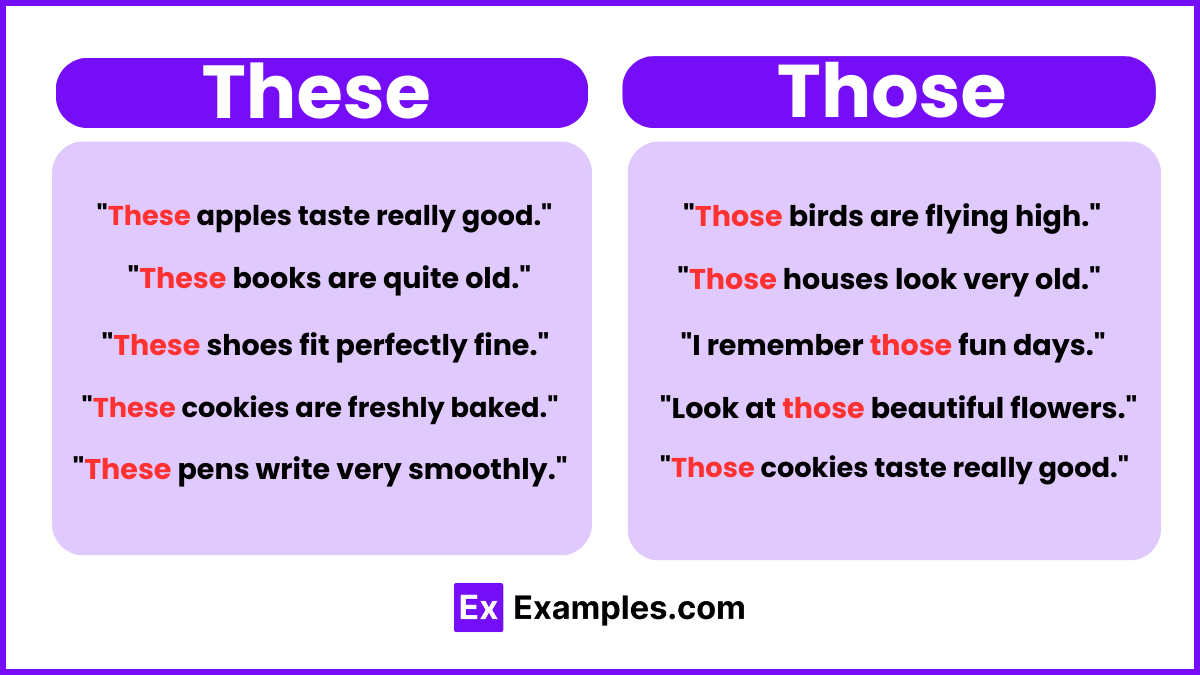These vs Those – Meanings, Differences, Usage, Examples, Tricks
Dive into the comprehensive guide on ‘These vs Those’ and unravel the subtle distinctions impacting communication dynamics. Explore practical examples illustrating the usage of ‘these’ and ‘those’ in various contexts. Enhance your understanding of how these terms affect effective communication strategies, enabling you to convey ideas with precision and clarity. Elevate your language skills and enrich your communication toolkit with this insightful exploration.
These vs Those – Meanings
- These: “These” is a demonstrative pronoun used to refer to objects or people that are near in distance or time relative to the speaker. It indicates items or individuals that are within the immediate vicinity or have been recently mentioned in the conversation. For example, “These flowers in the garden are beautiful” highlights flowers that are close to the speaker.
- Those: In contrast, “Those” is also a demonstrative pronoun but is used to indicate objects or people that are distant in distance or time from the speaker. It refers to items or individuals that are further away or were mentioned earlier in the conversation. For instance, “Those buildings across the river are historic” points out buildings that are far from the speaker.
Summary
How To Pronounce These and Those
How to Pronounce “These”
- Pronounced as [thēz].
- Begins with the voiced dental fricative sound [ð], similar to the “th” in “this.”
- Followed by the long vowel sound [ē], similar to the “ee” in “bee.”
- Concludes with the voiced alveolar fricative sound [z].
How to Pronounce “Those”
- Pronounced as [ᵻz].
- Begins with the voiced dental fricative sound [ð], similar to the “th” in “this.”
- Followed by the schwa sound [ᵻ], which is a reduced vowel sound similar to the “u” in “cup.”
- Concludes with the voiced alveolar fricative sound [z].
Differences Between These and Those
| Aspect | These | Those |
|---|---|---|
| Proximity | Near to the speaker | Distant from the speaker |
| Usage | Refers to objects or people nearby | Refers to objects or people further away |
| Context | Indicates items recently mentioned | Points out items previously mentioned |
| Demonstrative | Demonstrates proximity to the speaker | Demonstrates distance from the speaker |
How to Remember the Tricks
To distinguish between “These” and “Those,” utilize various mnemonic techniques:
Proximity Reminder:
- “These” resemble ‘this,’ indicating closeness.
- “Those” echo ‘that,’ implying distance.
Usage Trick:
- “These” pertain to items nearby.
- “Those” relate to items farther away.
Visual Association:
- Mentally grasp “these” for closeness.
- Visualize pointing to “those” for distance.
Temporal Context:
- “These” recall recent items.
- “Those” evoke previously mentioned items.
When to Use These and Those
Usage of “These”
- When referring to objects or people that are near in distance or time relative to the speaker.
- For items or individuals within the immediate vicinity or recently mentioned in the conversation.
Usage of “Those”
- When indicating objects or people that are distant in distance or time from the speaker.
- For items or individuals further away or previously mentioned in the conversation.
These and Those Examples
Examples with “These”
- These books on the shelf are mine.
- Can you pass me these pencils, please?
- These flowers in the garden are beautiful.
- I love these cookies you baked.
- These shoes are too tight for me.
Examples with “Those”
- Can you grab those papers from the desk?
- Look at those birds flying in the sky.
- Those houses on the hill look picturesque.
- I remember those days we spent at the beach.
- Those cars in the parking lot are expensive models.
Synonyms For These and Those
| These | Those |
|---|---|
| These ones | Those ones |
| This | That |
| These things | Those things |
| Here | There |
| Near | Far |
| Close by | Distant |
| Nearby | Further away |
| Present | Past |
| Current | Previous |
| Nearby items | Distant items |
Exercise
Instructions: Differentiate between “these” and “those” by completing the sentences with the appropriate word.
- Can you pass me _______________ pens on the table?
- I love _______________ flowers in our garden.
- _______________ cookies you baked are delicious.
- Look at _______________ birds flying in the sky!
- _______________ houses on the hill are quite old.
- I need to return _______________ books to the library.
- _______________ shoes in the store window caught my eye.
- _______________ days, we used to play in this park for hours.
Answers:
- these
- those
- these
- those
- those
- these
- those
- those
FAQ’S
What is the difference between those people and these people?
The difference lies in spatial proximity; “those people” refer to individuals farther away from the speaker, while “these people” are closer, typically within the speaker’s immediate vicinity.
Can I use these for a person?
Yes, “these” can be used to refer to a person or people who are nearby or within the speaker’s immediate vicinity, indicating spatial proximity.
What is those in grammar?
“Those” is a demonstrative pronoun in grammar, used to indicate objects or people that are distant in distance or time from the speaker, typically referring to items previously mentioned or understood.
Which is correct this days or these days?
The correct phrase is ‘these days.’ It refers to the current period or present time. ‘This days’ is grammatically incorrect; ‘these’ indicates plural, whereas ‘days’ is plural.




